 |
|
|

Photographing Wild Horses
on North Carolina's coast
|
Shackleford
Banks (Cape Lookout National Seashore)
Rachel Carson Estuarine Reserve (Beaufort, NC)
Corolla/Carova (Currituck Banks)
I
have focused exclusively on my bird photography in these pages,
but I would be remiss if I did not devote some space to talk
about my other main photography interest, the wild horses of
North Carolina's coast. For starters, you should read through
my article
at NCWildHorses.com, covering a four-day "safari" of Shackleford
Banks and the Rachel Carson Estuarine Reserve at Beaufort. It
will give you a well rounded introduction to the interesting
options in that area for wild horse photography.
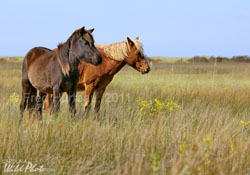 |
| Stallion
and mare on Shackleford Banks |
Besides
Shackleford Banks and the Rachel Carson Reserve at Beaufort,
there is a third location on the northernmost coast of the Outer
Banks, between Corolla and Carova. The NCWildHorses.com web
site also has more information on that location, as does my
CarolinaOuterBanks.com section on the wild
horses of Corolla.
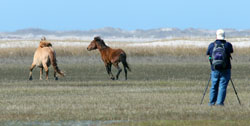 |
Photographing
on the salt marsh at
Rachel Carson Reserve |
Corolla, Shackleford and Rachel Carson differ in how you
go about reaching them and the types of shots and scenery you
can get, and each is under the jurisdiction and supervision of different agencies. Each location has similar regulations about how
close you are allowed to come to these wild animals (no closer
than 50 feet). Very often you can actually get that close, but
there are no guarantees.
Lens Choices:
The long telephotos you use for birds are not always necessary, as a rule, for subjects this large, certainly not for distances of 20 yards. I've used a 24-105mm, a 70-200mm and a 300mm in the past to cover all the bases. Now though I just carry my 100-400mm. Keep in mind these are wild horses that go wherever they want to. On rare occasions I've wished I had the 500mm with me, but that's a two-edged sword. The farther away they are in this coastal air, the more haze you can encounter, so moving closer if you can for the shots is the better answer. Also, the terrain can be challenging, and sometimes you will be unable to get as close as you would like. For example, at Beaufort and Shackleford the horses may be frolicking on a shoreline beyond water too shallow for a boat, or a bit too deep to safely wade closer with a camera. Or you may need to cross mucky marsh mud, laced with starp, jagged oyster shells, and not have proper footwear for the situation.
Besides the horses, these environments
can present opportunities for great bird photography, so having
along your big glass for birds may prove valuable to you. Of
course there are scenic and landscape opportunities here too.
That favorite wide angle in your camera bag could prove handy.
What it boils down to is "bring whatever you're willing to carry".
Keep in mind though that these locations will require some hoofing
it, so keep your total equipment weight to something you can
handle.
About Corolla/Carova:
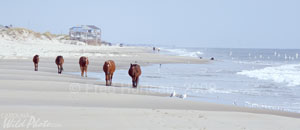 |
| Horse
groups hug the surf line |
Reaching
the wild horses north of Corolla on Currituck Banks requires
4-wheel drive, whether you drive your own or ride in someone
else's, such as with one of the tour companies out of Corolla.
NC Highway 12 dead ends onto the beach at Corolla, and the 11
miles from there to the Virginia border is 4-wheel drive only.
Beyond Corolla there are no gas stations, no businesses and
no facilities of any kind, just wildlife reserves and small
beach communities of homes. You should be aware that sections
of this beach are littered with tree stumps from an ancient
maritime forest, which most surely can be a serious driving
hazard. (See my web pages regarding this phenomenon at this
CarolinaOuterBanks.com
link.)
About 100 horses
are sequestered on the northernmost end of the Currituck barrier
island between two fences that stretch from ocean to sound.
One fence is just north of Corolla where Hwy. 12 ends onto the
beach, and the other is on the North Carolina-Virginia border.
The fence crosses the beach here too, which also keeps vehicles
from driving into Virginia. The fences keep the horses from
wandering south into Corolla and being hit by cars on the highway,
and keeps them out of False Cape State Park along the Virginia
border.
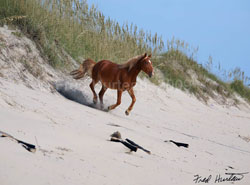 |
| Galloping
down a high dune at Carova |
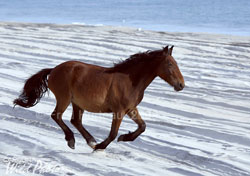 |
| Galloping
on the beach at Carova |
Arguably
the best photos of these horses can be obtained on the beach,
which is certainly a rather unique backdrop. The beach faces
east with generally high dunes on the west side. When the horses
venture onto the beach, which they use as a trail between feeding
areas, they usually keep near the surf. Photographing early
in the day will mean you tend to be shooting into the light
with dark subjects backlit against a light sky and shiny water,
unless of course, you want to stand waist deep in the ocean
and shoot from there. That doesn't make things easy. At high
tide you will often have little to no room on the beach in which
to work, so being aware of the tide schedule is important. Remember,
you must keep 50 feet or more away from the horses. Despite
the challenges, it is occasionally possible to get some interesting
shots, such as the one at left, where I lucked into a group
of horses that decided to move onto the beach from atop a 30-foot
high dune.
Sometimes
all you need is a bean bag in your window or on the hood for
shots on the beach, assuming you're parked at a good angle in
relation to the horses. You may spend quite some time parked
on the beach waiting for action. You can see a couple of miles
up and down the beach, so binoculars will help you tell the
difference between horses and people when you spot distant figures
in the hazy air. Otherwise, getting out for handheld shooting
or to use a tripod is necessary. Generally, walking over the
dunes to scout for photos requires only short treks lasting
a few minutes, so taking a bag or backpack is relatively easy.
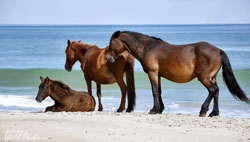 |
Horse
family on the beach
|
Just finding
the horses out on the beach is a combination of luck and patience.
Do not expect you will be alone either, for much of the year
the beach is a busy "highway", not to mention the tourists.
(Note the beach is literally covered with vehicle tracks
in the photo
at left.) The heat of summer and pesky insects helps
drive the horses onto the beach or just behind the dunes where
the ocean breeze offers some relief. The problem is, they swap
the pesky insects for the pesky tourists and traffic that infests
the beach. I never bother going between June and September.
I recommend avoiding summer altogether .... you're outnumbered,
and taking a photo of a horse on the beach is all but impossible
without also getting a dozen tourists and/or cars ln the frame.
Early spring and late fall are better times, while the weather
is still fairly warm. Windy and cold weather keeps the horses
sound side among the trees of the maritime forest, and out of
the wind. The tourists mostly fade away during October, except
for the weekends. The weekends can be nearly as problematic
as the tourist season until November rolls around. The same
is true during May, which can be suitable during the week, but
forget weekends. It is more often than not a complete waste
of your time during tourist season, and you will virtually never
find horses on the beach in bitter weather.
You can
also drive over the dunes and through the housing areas to find
horses wandering about in yards and on the sand paths that serve
for roads. While those images may satisfy the tourists' curiosity,
they are hardly worth the time of any serious photographer as
photos of "wild horses". Compounding the problem is the fact
you cannot tell where public "roads" end and private property
begins. The "roads" are so narrow and riddled with huge mud
holes, they're not safe to drive, and often not passable. After
a few such forays, I quickly tired of it.
Climbing
over the dunes and scouting behind them on foot can provide
opportunities in the more open areas between the beach communities.
Case in point: I was once photographing a stallion and
mare grazing behind the dunes when the stallion suddenly took
off at a gallop and ran some 300-400 yards from the beach to
the distant tree line. Apparently he went to retrieve a wayward
mare, and chased her the entire distance back towards me. The
sheer terror on that mare's face is unmistakably evident in
the series of photos above. I was shooting with a 70-200mm on
a full frame body, because I was just there to take some short
distance shots of them grazing near the dunes. I had not expected
a long distance chase and was unprepared with no long telephoto
handy. The moral to the story is....if you think you won't need
it, bring it anyway.
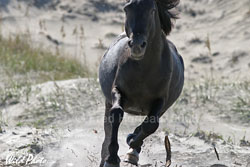 |
| Charging
over the dune |
My point
here is that although the horses tend be somewhat predictable
once you are familiar with their habits, they can also be completely
unpredictable. They occasionally provide this sort of surprise
action which, along with the classic fights between two (or
more) stallions, makes photographing them such a rewarding challenge.
You eventually learn to read their body language and therefore
are more prepared when such action breaks out. It doesn't mean
you will be in the best position for photos when it happens,
but sometimes it gives you enough warning that you can at least
make the best of it. At other times you have no warning at all.
Once I was parked parallel to the beach, up next to the dunes,
patiently watching far down the beach when I caught motion in
the corner of my vision. A black stallion came charging over
the dune right next to me, headed straight for my truck. Out
of sheer reflex I grabbed my camera from the seat next to me,
blindly pointed it at arms length toward the passenger window
and squeezed. A second later he veered around the truck and
out onto the beach. The shutter happened to be in continuous
mode, and still I only got four frames before he was gone. At
left is the first and best frame, an uncropped image. The other
three were completely out of focus and useless. It happened
so fast it's a wonder I got anything at all.
To sum up
the Corolla wild horses, accessing them requires only a 4-wheel
drive to get there. It is possible to just park on the beach
and wait for a family group to stroll by. You may spot a few
grazing behind the dunes, or you might brave the deep sandy
paths and huge mud holes to drive around for hours and never
see even one. It has happened to me more than once. If you know
where to go on foot without trespassing on private land, you
can trek out to the sound side maritime forest and marshes to
get "natural" photos, but I have not learned those places yet.
That will require a local guide who knows the areas off the
beaten path and has permission to use private property. But
if you have the time, patience, luck and persistence, it's not
at all "difficult" to at least get worthwhile photos of the
Corolla wild horses on the beach.
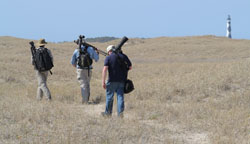 |
| Oceanside
rolling dunes |
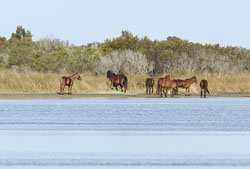 |
| Sound
side maritime forest |
About Shackleford Banks:
Shackleford
is a completely different situation from Corolla. It's an unpopulated
barrier island about a half-mile wide by 9-miles long, with
the only access being by boat. Kayaking here is an option, but
the distances are much greater than at the Rachel Carson Reserve.
I wouldn't recommend kayaking from the mainland without a touring
class kayak and experience on open water that can get rough.
Passenger ferry service and charter service is available out
of Beaufort.
Shackleford
is part of the Cape Hatteras National Seashore, and the island
and horses are under the jurisdiction of the Park Service. The
same 50-foot approach rule is enforced here. The most often
visited area to photograph the wild horses here is the easternmost
end of the island, adjacent to Cape Lookout. The ocean side
of the barrier island is open, with high and dry undulating
dunes of grasses as in the photo at right. The sound side of
the island is maritime forest and thickets mixed with tidal
marsh wetland, and small grassy islands that may flood at high
tide, but be barely above water at low tide.
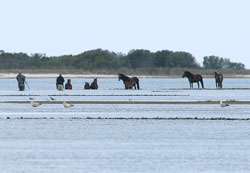 |
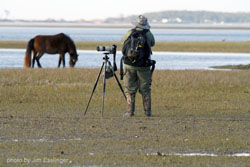 |
| Wading
sound side to reach horses |
Sound
side island at low tide |
It is a
good idea to wear boots and clothing suitable for muddy, marshy
trekking. Better yet, be prepared to wade through salt or brackish
water from 6 inches deep to two or even three feet deep. I have
used both calf-high neoprene kayaking boots and knee-high waterproof
snake boots. My snake boots are great for hiking, mud, and shallow
water, but for the deep wading I recommend something different.
I have ankle-high water rescue/first responder type boots with
neoprene inserts, the sort of footwear Navy Seals use. These
are designed with neoprene tops like a wet suit, with thick
treaded soles for hiking and mud, and can be used IN the water
of any depth. I wear a neoprene bootie/sock inside them for
extra comfort, which also makes the boots easier to slide on
and off. I also wear thin fast-dry hiking pants with zip off
calves, which can also serve as a bathing suit for when the
water gets thigh-deep to waist-deep. The same type of fast dry
shirt (like a fishing shirt) is a good idea too. If all else
fails, bring an old pair of sneakers you don't care about ruining
in marsh muck and salt water, but proper hiking footwear is
a better idea. You do not want to go barefoot or in flip-flops
wading in these areas. Marsh muck will suck off anything not
strongly attached to your feet, and beware of shells and other
sharp surprises that lurk beneath the water. Be safe and smart.
Come prepared.
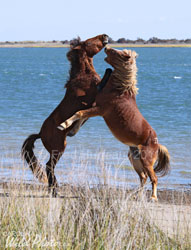 |
Shackleford
stallions'
disagreement |
Mud, muck
and unknown underwater surfaces can be slippery, so you may
want to bring a hiking pole for extra stability. Slipping and
falling in two feet of salt water with a backpack or handful
of expensive camera gear would be a disaster. The extra leg
provided by a pole can prove invaluable, not to mention you
can use it as a depth finder to test the water depth ahead of
you. I use an aluminum ski pole I found at the Goodwill Store
for $2.00. I scuffed it with sandpaper and sprayed it with a
pattern of camo paint. Then I added three colored stripes across
it - a green stripe for ankle depth, yellow for knee depth,
and red for crotch depth. It won't rust, and if it gets lost
I'm only out $2.00. It's not collapsible, but for a couple of
bucks you can't have everything. At least I'm not likely to
unexpectedly find a deep hole with my foot before the pole finds
it.
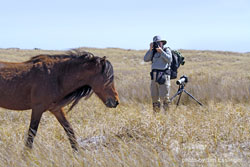 |
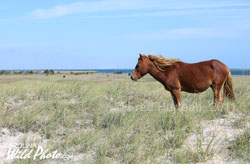 |
| Short
lens shooting on Shackleford |
Open
spaces on Shackleford |
Whatever
you bring, remember you have to get on and off a boat with your
gear. A single backpack of gear and a tripod is enough to carry
around, load and unload. The boat rides can be choppy and rough
at times, often with salt spray, so provide cover for your gear
in transit. Even if the weather is pleasant, the wind can be
chilly at boat speeds, so have something warm to wear that's
packable when not needed. There are also no facilities on Shackleford.
The Park Service does have a couple of compost type toilet buildings
on the island, but they're far from the east end. Bring water
and snacks with you, and carry off your trash.
Shackleford
has about 100 horses in residence, but they are spread out across
a nine-mile long island. The most common sightings are groups
of two to four, though I have seen as many as eight in a group.
If you see a dozen wild horses during a single outing on Shackleford
you've had a good day. It's not uncommon to hike from one to
three miles on an outing here. It's also possible to luck into
a couple of family groups in plain sight out among the grassy
dunes where you land the boat and you won't have to wade the
marshes, streams and sloughs to get your shots.
About The Rachel Carson Reserve:
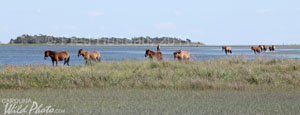 |
Horses
returning from feeding in
the tidal marsh at Rachel Carson |
The Rachel
Carson Reserve is similar to Shackleford, requiring a boat to
reach it. Passenger ferry and shuttle service is available from
the Beaufort waterfront on Taylor Creek, as is charter boat
and guide service for small groups. Kayaking is a reasonable
option, as the distance between the waterfront and the reserve
is just two hundred to three hundred yards. Crossing by kayak
and hiking the area is a very practical option.
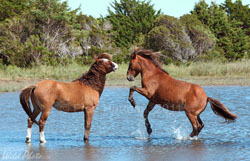 |
Stallions
test each other
at Rachel Carson |
The reserve
is part of the N.C. Coastal Reserve and National Estuarine Research
Reserve. [Do not confuse this location with the Rachel Carson
National Wildlife Refuge which is in Maine] Unlike the Corolla
herd and Shackleford herd, these horses are considered "feral".
They originated from Ocracoke and Shackleford horses, which
are considered descended from the Spanish Colonial stock brought
by early explorers and settlers. However the Rachel Carson herd
was mixed with some thoroughbred and farm stock decades ago, before
the horses or property came to be the Rachel Carson Reserve.
The reserve
has maritime forest and brush, and large areas of tidal marsh,
but there is much less in dry grassy areas here, and distances
are much shorter than at Shackleford. The whole island complex
is one-third that of Shackleford, with much more of it being
tidal marsh than dry land area. There are only about 35 horses
here, but they are generally much easier to find. Unlike the
Shackleford horses, which tend to keep their family groups of
3-5 horses mostly isolated from other family groups, the Rachel
Carson family groups seem to tolerate other family groups more
easily. Thus you will often find several family groups in close
proximity while grazing. This provides a better concentration
of horses in one area as subjects. It also means you are more
likely to encounter interesting action, such as stallions taking
exception to each other's presence. I have witnessed only one
such encounter on Shackleford, but have seen several at Rachel
Carson, some of which were only quick scuffles. They still provided
good action for photos though.
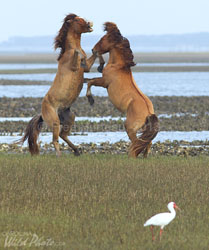 |
Stallions
at Rachel Carson
Reserve |
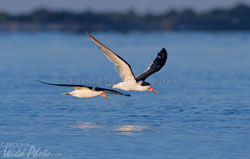 |
| Black
Skimmers at Rachel Carson |
The same
sort of footwear and clothing as Shackleford is recommended
here also. Something to consider at both locations is the damp,
marshy ground of the tidal marsh at low tide. You might bring
a large trash bag, a 2x2-foot piece of heavy plastic or other
waterproof ground cover to set your backpack or camera bag on
when swapping out lenses and bodies. Keep in mind the wind can
easily carry off such plastic items if you're not careful. To
keep muck off your tripod leg locks, you can extend the smallest
leg sections just six inches or so, keeping the lower leg locks
away from the ground without adding unnecessary flex to your
tripod. Then just get your needed height from the upper leg
sections.
The greater
accessibility of the extensive tidal marsh at Rachel Carson
will provide more opportunities than Shackleford for some great
bird photography. This is especially true when kayaking into
the tidal marsh at high tides. Depending on the season, you
can get close access to the horses feeding on the marsh, as
well as spectacular flocks of Black Skimmers, plenty of White
Ibis, and a plethora of peeps, sandpipers, yellowlegs, oystercatchers,
and even an occasional loon. Paddling the marsh can be a tricky
business though. The good thing is if you get caught with the
tide going out, you can just get out and walk..... not that
it's much fun having to do that. Hitting the tide just right
takes some knowledge and experience, but it can be done with
great results. Be warned that the sharp dangers of extensive
oyster beds here must not be ignored, whether wading or paddling.
Advice on Clothing and Footwear:
Although I mentioned
footwear and clothing in the above sections, this section will cover
clothing and footwear in more detail. It goes without saying that
sun screen lotions are advisable any time you're out in the sun and
nature.
For Corolla - you will be mainly
on sand, whether soft and deep, or hard packed. Suitable shoes or
even sandals work fine, keeping in mind the air temps. Shoes with
higher tops will obviously help to keep sand out. At Corolla you might
wish to shoot from the surf toward the beach so the sun is to your
back, so the right footwear and fast dry clothing would be recommended.
When shooting from the surf , water sandals, water shoes or perhaps
even bare feet in warm weather would work. Short pants or fast dry
clothing is a good idea too, since your legs will certainly get splashed.
For Shackleford Banks and
Beaufort (Rachel Carson Reserve) - the terrain is much more
varied on these islands. You will encounter all of these: (1)
wading in water from one inch deep to one foot deep (and up
to 2-3 feet deep on Shackleford if you are adventurous), (2)
soft dry sand, (3) soft wet sand,
(4) packed sand, (5)
mucky, slippery mud (often laced with sharp, jagged oyster shells),
(6) short grass, knee-high and
waist-high grasses (often laced with light briars), (7)
burrs that grab onto everything like velcro, (8)
scrubby cedar thickets with lots of dead dried branches that
can scratch, (9) and at times,
mosquitos.
While that
may sound like a daunting list, it is really quite manageable.
The briars, burrs and especially mosquitos are a minor distraction,
and mainly something to be mindful of.
For the months that I visit these places (April, May, early
June, October & November) I've seen very, very few mosquitos.
Usually the breezes simply keep them blown away, while long
pants, long sleeves, very light gloves and mosquito repellant
easily take care of it the rest of the time. I also have use
of a mosquito net that hangs over my hat, since I hate using
mosquito repellant. Actually though, mosquitos are the last
thing I have on my mind. And those small dead cedar branches
are only an issue if you wish to take shortcuts through the
cedar thickets. Otherwise, the landscape is quite open. The
real issues are the mud and varying depth of water.
I nearly always
wear fast dry pants (with or without zip off legs) and fast dry shirts
(long sleeve). I get the "PFG" (performance fishing gear) type of
shirts from Columbia, as well as Columbia pants. There is a Columbia
outlet store very close to me, so it's quite affordable. I have both
insulated and lightweight water repellant jackets, depending on the
season. A jacket hood is handy too. If you're taking a chartered boat
to reach the islands, the boat rides at speed in cool air can quickly
turn from chilly to downright cold, so depending on the season, you'll
want the option to block the wind. If you wear brim hats to keep the
sun off your face as I do, a chin strap on your hat is a must so a
boat ride can't blow it off. You can encounter some salt spray on
the boat, especially on windy days with choppy water, so a spare towel
or such is handy to cover exposed camera equipment to avoid getting
it sprinkled.
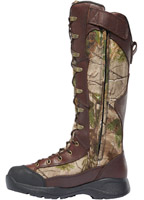 |
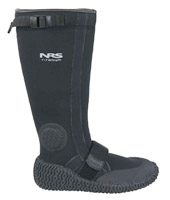 |
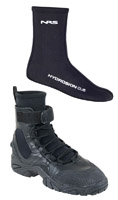 |
18-inch
snake boot |
kayaking
boot
(NRS Boundary Shoe) |
Workboot/wetshoe
and wetsock |
And now to the
footwear. I've collected and use different kinds of footwear for various
situations and conditions.
(1) Water shoes/ water sandals - I have simple water shoes
and water sandals, which are suitable for photographing on the beach
or from the surf at Corolla. I would NOT use these at Shackleford
or Rachel Carson (Beaufort). The marsh muck will suck them off your
feet in an instant, and they offer no protection from briars and burrs.
(2) Snake Boots - My zip side snake boots are very comfortable
for trekking. I sometimes use them at Shackleford and Beaufort, but
only if I will not be hiking through the deep mucky marsh mud, or
wading in water deeper than 6 inches. These are waterproof to a point,
and great against briars and burrs. Deep mud will not tend to suck
them off my feet, but I don't like having to clean the black mud off
them. So long as I keep to mud no deeper than a couple of inches it's
no problem. They are sturdy and protect against the occasional sharp
oyster shell. I do not wear them because of snakes, I wear them for
comfort. I've only ever seen one snake on these islands in all my
many trips.... a small harmless 18-inch black snake.
(3) Kayaking boots - I really like my NRS
Boundary Shoes, not only for kayaking, but for trekking on these
islands. They are supremely comfortable, waterproof, and have a tough
treaded bottom that protects from shells. The tread provides grip
in muddy and wet sandy situations, and the black marsh mud hoses off
them well. Burrs do stick to them sometimes, but they protecet well
from briars. Wading in a foot of water is no problem with these, and
the mucky mud will not suck them off my feet. What I cannot do with
either these or the snake boots is wade in water over 12-14 inches.
Obviously the water can go over the top and into the boots. While
that is a major issue for the snake boots, it's not actually a problem
with neoprene boots, except that I end up with wet socks for awhile.
Since they are neoprene inside and out, they will wash up just fine.
(4) Workboot wetshoes - My NRS
Workboot wetshoes are my go to footwear when I have to wade deep.
This is the kind of footwear first responders and Navy Seals wear.
They're rugged, and designed to be underwater, like a wetsuit. Marsh
muck will not suck these off your feet. In fact, they're a bit of
a struggle to get on as well. I always wear a pair of wetsocks
with these, as it makes it supremely easier to get the boots on and
off. This is what I wear at Shackleford if I need to wade in deep
water to get closer to the horses. They are an all-round solution
for every situation - mud, sand, any depth of water, high grass, briars
and burrs, and they protect against those hidden objects underwater
when wading. Being neoprene, they are completely submersible and washable
inside and out, so marsh muck and mud can be cleaned off.
(5) Other suitable footwear - Muck Boots (it's a brand), and
other kinds of mud boots will do, but you want them to be comfortable
for a day's worth of trekking. If they're not comfortable for walking,
you'll regret wearing them. Most mud boots are not really meant for
hours of wear, so choose carefully. They need to be comfortable and
waterproof. They do not need to be insulated for cold weather. The
lighter weight they are the better for hiking they'll be. And be sure
they are not prone to slipping off easily. You don't want the mud
to suck them down and yank them off unexpectedly.
(6) What NOT to wear - Don't wear your good dry land hiking
shoes. Do not wear sneakers, sandals, water shoes, deck shoes, or
anything cut below the ankle. They can easily be sucked off by the
mud you will encounter, and will be ruined as well. At least above-the-ankle
shoes/boots can be tied tightly enough so they will resist being sucked
off. If you have to wear old sneakers, wear ones you can afford to
trash after a day's trek in mud and salt water. But you will have
to be careful to avoid the deeper mud while on the islands.
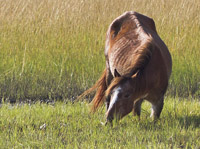 |
|
Even the horses can sink
into
the mud
above their knees |
|
I don't mean to harp on the mud.... but...it's important
to understand that there are places where you can sink up to your
knees or worse if you are not careful. Even the horses can sink
in the mud up to their bellies. If you've ever done any photography
in a freshwater marsh, you'll know that you can sink into the muddy
bottom. A salt water marsh is no different. This creates a vacuum
and refuses to let go of your feet. No matter whether you sink 6 inches
or two feet, it can and will throw you off balance. Now getting wet
and muddy is certainly not fun, but it won't cause you permanent damage.
However, if your camera gear ends up wet and muddy, it will be a disaster,
and at the very least will ruin your photography outing. On these
islands you can avoid the mud by simply not walking in it. But that
can limit your photo opportunities. Mostly the mud is a couple of
inches deep, but even that much can be very slippery. Whether slipping
and falling, or getting stuck and loosing your balance, the end result
will be the same.
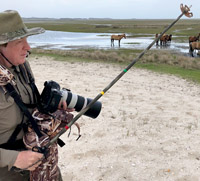 |
$2
hiking pole |
So what should I do? (1) Follow
this rule - stay on the horse paths whenever possible. The
horses walk there because the ground is firmer than elsewhere, and
the paths get packed firm. You can easily see these paths across the
marsh. They are bare of any grasses. You can't miss them. You can
even see them in satellite photos. Use them.
(2) Consider using a hiking pole as I mentioned earlier in
this article. To recap, mine is an old aluminum ski pole I found for
$2 at the Goodwill store. I put a nylon cord on it for a wrist strap
so I can let go to use both hands for photography without dropping
it. I sprayed it with camo paint, and put green, yellow and red stripes
on it to mark different depths. I can prod the water ahead of me to
check the depth when wading. It gives me a third leg for stability
in slippery mud. I can use it for a pseudo monopole by propping my
lens foot on it to steady a shot. Being aluminum it will not rust
from salt water. And best of all, it was only $2. That's really cheap
insurance against a disaster.
Final Thoughts:
My favorite of the three locations is the Rachel Carson Reserve. It gives me the option of enjoying some kayaking along with my photography, with opportunities to capture images of both birds and wild horses. What I don't like are the limited lodging options in the Beaufort/Morehead City area. Only a couple of motels in Beaufort are close to the reserve and provide space to park a vehicle pulling a boat trailer. More choices are in Morehead City, but it takes a few minutes to reach Beaufort from there, which can be a hassle if you're on an early schedule to meet up with a tour boat or charter boat. The options within Beaufort are better if you're not pulling a kayak trailer.
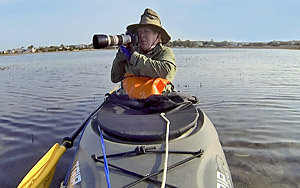 |
| Kayak
photography on the tidal marsh |
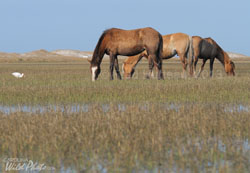 |
View
from kayak on Rachel Carson
Reserve tidal marsh |
I hope this
has provided some useful information from a photographer's perspective
to help you get a feel for which of these locations might suit
your interests as a photographer. Along with the links provided
to NCWildHorses.com and CarolinaOuterBanks.com, you should have
a better idea of what to expect when visiting each of these
wild horse populations on North Carolina's coast. I did not
include the Ocracoke horses for the simple reason they are penned
behind such a ridiculously high fence they aren't even of much
value as a cheap tourist attraction, and are certainly of no
photographic interest. Shackleford Banks, Rachel Carson Reserve
and Corolla have more than enough to offer for wild horse and
bird photography to make a trip to any of them a worthwhile
and rewarding excursion. |
|
 |
|
 |
